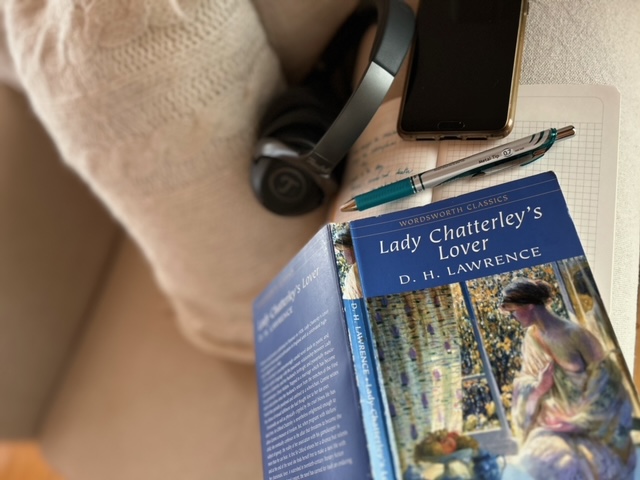I first came across D.H. Lawrence’s Lady Chatterley’s Lover about 10 years ago, and I thought I might just give it a shot. I had no particular desire to read it, I just thought it might be a nice addition to my ever-growing library. Maybe that’s why it didn’t work out for me back then. I ploughed somehow through the first chapters up to the scene where Connie contemplates (there really is no better word for how she looks at him) Mellors as he washes himself outdoors, unaware of her presence. Then I stopped. Absolutely nothing stayed with me from that first failed attempt at reading the book, except for this scene in the woods.
I don’t know if I know better now, but I do know at least how to tackle a book which might be difficult to get through. I took a deep breath, remembered how I read other Modernist novels, and decided this was it. This was the point in time for me to read Lady Chatterley’s Lover. And I absolutely adored it. This time over, the descriptions of the woods in springtime were pure joy to read and the difficult dialogues and debates on social topics in the Chatterley’s salon had a clear place in the larger narrative. I think last time I had the wrong expectations. I thought somehow Connie and Mellors fall in love and get on with it. It’s really not that easy, I know now. Connie was sunk in deep depression before meeting Mellors and Mellors himself has some faults of his own, far from being the ideal male Lawrence would maybe like to present.
Even if the depiction of male and female sexuality and political stances are, at least from the present perspective, flawed at times, Lawrence’s novel makes for a rewarding reading experience and asks questions beyond the obvious ones. Is love a stand-in for immorality? What is morality, after all, and who sets the limits? Does love have anything to do with politics? Of course, the answers, if they even exist, are far from easy. The most certain way to know is, of course, to read the novel by yourself. And if you had trouble with it, like I did 10 years ago, no worries, I got you covered.
know lady chatterley’s lover beyond the spiciness
If you pick up the novel thinking it is a scandalous love story between an upper-class woman and a working-class man, you might be right. But we need to start with the basics. D.H. Lawrence published the novel privately, in Florence, in 1928. Because of the scandalous content, the book was censored and stood a trial which eventually ruled in its favour. In 1960, Penguin published the first complete text of the novel, with the picture of a phoenix in flames against the iconic orange background. Maybe that helped popularize the novel, for it sold our real quick once the word got out.
D.H. Lawrence was born in Eastwood, in 1885, the son of a teacher and a coal miner. His characters are often working-class and in his last novel, Lady Chatterley’s Lover, the opposition and interdependence between “ruling class” and “the masses” gains a central role. The novel is the love story between Lady Connie Chatterley, the wife of Sir Clifford Chatterley, and Oliver Mellors, the gamekeeper of Wragby Hall, the Chatterleys’ country estate. Connie comes from a middle-class family, and benefited from an “aesthetically unconventional upbringing”, already having had love affairs before marrying Clifford. Clifford, on the other hand, was upper-class, conservative in his views that social classes can’t mix, yet skeptical of any sort of authority figures. He fights in the Great War and comes back home crippled, being left only with the authority conferred by his money, and a mind which lacks any real-life experience.
In In the autumn of 1922 the couple moves to their country estate, at Wragby, a mansion in the vicinity of Tevershall, a coal mining village. The relationship between Connie and Clifford is reduced to his selfish need for her, her transcribing his literary writings, and, for Connie, a void and a non-existence. When Connie stumbles across Mellors washing himself in front of his cottage in the woods, her inner self is reawakened and, under his touch, she slowly starts coming back to life.
set a limit – first 5 chapters
Like many of Virginia Woolf or Sylvia Townsend Warner’s works, D.H. Lawrence’s novel is written in the free indirect style, specific of Modernist writing. Modernism, as a literary movement, believed in individual experience and in a subjective take on the world, and both aspects are conveyed through the style of writing. The narrator moves from character through character and we, the readers, look at the narrative as if through each character’s eyes. We empathize with them, but also see their faults.
The first chapters of the book introduce the characters through the free indirect style. We learn how Connie and Clifford met, their decision to move to Wragby, how separate the worlds of Wragby and Tevershall are, and how lonely and disconnected Connie feels. Connie slowly comes to understand Clifford’s lack of anything alive, his withdrawal in the “life of the mind” and his desire to have a son purely as an heir to Wragby, with her as a simple tool to make this happen.
He was not in touch, he was not in actual touch with anybody, save, traditionally, with Wragby. Beyond this nothing really touched him. Connie felt that she herself didn’t really, not really, touch him; perhaps there was nothing to get at ultimately; just a negation of human contact.
commit to your reading
Some sections of the book are easier to read, while others are more difficult. My favourites were the passages written in a free indirect style, where the characters recall past times or ponder on matters of life, politics and society. The dialogue is not always the fastest to read, especially when Mellors speaks in dialect, but this is itself part of the meaning that the book brings across. Language is the way people express their inner selves, and the moments Mellors chooses to speak dialect or standard are hints for us how to perceive the different facets of his personality. Such segments are worth even reading out loud just to get a feeling of how his dialect might sound.
I think Lady Chatterley’s Lover is a book worth returning to, and not just for the beauty of the writing, the portrayal of springtime woods in spring and the poetic, if a bit naive, depiction of sex, which even nowadays lies still somewhere between utopia and ridicule. I’m not saying the way Lawrence wrote sexuality is anywhere near realistic. But it is a depiction which goes beyond eroticism. Almost 100 years after having been written, the book still invites us to consider how far our society has come in talking about these matters in a grown-up way. If at all.





your thoughts?